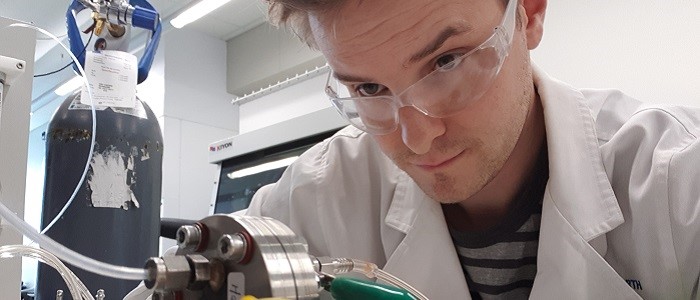News
3D printing bone tissue
Jun 28 2022
ACES PhD graduate Dr Ciaran McDonnell-Worth has been working on Electrochemical Nitrogen Reduction to produce ammonia as part of the MacFarlane Group at Monash University in conjunction with a number of ACES researchers.

The production of ammonia is currently contrived using the Haber-Bosch process which coverts nitrogen to ammonia through a reaction with hydrogen. This process has been used for around one hundred years, however is under debate as it uses high temperatures (500 degrees Celsius) a large amount of fossil fuels, high pressure methane gases (around 200 atm) and produces a significant amount of pollution.
The Electrochemical Nitrogen Reduction method being researched by Monash, differs from the Haber-Bosch process as it uses more mild reaction conditions such as lower temperatures (100 degrees Celsius), pressures (1 atm and up) and can be powered at a lower cost and by renewable energy sources, therefore producing less greenhouse gases. This device has the potential to work alongside a number of renewable energy devices that are being researched at ACES.
Ammonia is predominantly created for use in agricultural fertilisers in the form of salts, solutions or anhydrously which helps to produce an increased yield of crops. Nearly 200 million tonnes of ammonia is produced globally each year. The N2 Reduction process is potentially a huge game-changer for agribusiness with increased awareness of environmental impacts and financial disincentives such as the Carbon Tax.
In order to create the ammonia, a nitrogen reduction reaction (NRR) is performed on an electrocatalyst, a material that facilitates the transfer of electrons from the electrode to the nitrogen on the surface of the electrocatalyst (part of the overall reaction that produces ammonia). This electron transfer takes place due to electric potential energy being applied in the form of a power supply, forcing the electrons to move around the system, interacting and reacting with the N2.
As with any electrical device you need to complete the electrical circuit in order for the reaction to take place. If electrons are put into the nitrogen reduction reaction, then then have to be pulled out somewhere else. This is done using a second electrode that could be oxidising something such as water to oxygen producing electrons and protons.
The electrons flow around the circuit to the N2 electrode and the protons flow from the H2 electrode, through a proton-conducting medium to the surface of the N2 electrode where they react with the N2 and electrons to form NH3, ammonia.
The proton-conducting medium is called an electrolyte and separates the two electrodes while allowing protons to move between them, completing the circuit between the two electrodes. The electrolyte also acts to carry the N2 and the protons so that they can diffuse to the surface of the electrocatalyst and react to form ammonia.
The team at Monash University has chosen to use ionic liquids as an electrolyte in this research as they are made up of positively and negatively charged molecules (cations and anions) which can conduct charge. The ionic liquids that they have chosen to use are heavily fluorinated which have previously been shown to have high N2 solubility. This means that more N2 can be forced into the electrolyte, resulting in more N2 reacting on the electrocatalyst surface to form NH3 (ammonia).
Researchers at Monash University are currently looking at creating better electrocatalysts so that the electrical potential energy needed for the N2 reduction is lowered and used more efficiently. They are also looking at different types of electrolyte and at scaling up the process towards commercial viability.













